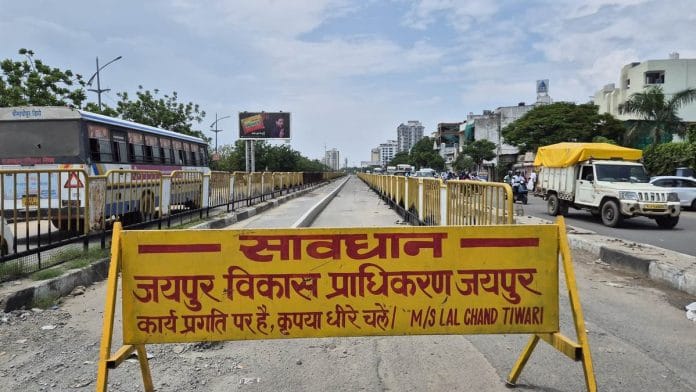Jaipur/Hubbali-Dharwad: The best infrastructural development in Jaipur recently has actually been a demolition. That’s what Ayushi Aggarwal said as she cheered the day the Rajasthan assembly announced it would dismantle the city’s dreaded Rs 500-crore Bus Rapid Transit System, or BRTS.
“They serve no purpose. I have never used a bus on it, and the traffic as well as noise ruined our lives for the period it was there,” said Aggarwal, an HR manager. “I am happy it is being removed.”
When BRTS was launched 15 years ago, it came with the promise of making Jaipur a ‘world class city’—touted as the city’s answer to its public transportation problem. It didn’t take long for the hellish urban nightmare to unfold. Barricades split key roads and worsened congestion. The promised fleet of 300 buses never traversed it.
And it’s not just Jaipur. BRTS corridors across India are being dismantled. Championed by the Centre in 2006 as the futuristic antidote to traffic snarls, they’ve only aggravated existing problems. Traffic cops count the corridors as a nuisance. Car owners say their right of way was taken. Pedestrians say they are hazardous to cross. State governments are now listening. They have no option under the volley of people’s pressure.
Delhi, which launched BRT in 2008, was the first to junk it. The Madhya Pradesh government removed it from Bhopal. The MP High Court has ordered it to be scrapped in Indore. Pune, home to the country’s oldest BRT system, has started tearing down its barricades. In Karnataka’s Hubballi-Dharwad, the protests of residents are intensifying.
The BRT has become a dubious mascot for India’s malfunctioning urban transport. Each city has its own mess but they all tell the story of top-down, imported solutions marred by poor implementation. It’s part of a larger pattern where ballooning and strained Indian cities are being bombarded with half-baked, borrowed fixes for everything from garbage and housing to traffic and roads. In trying to solve one problem, governments end up creating three more.
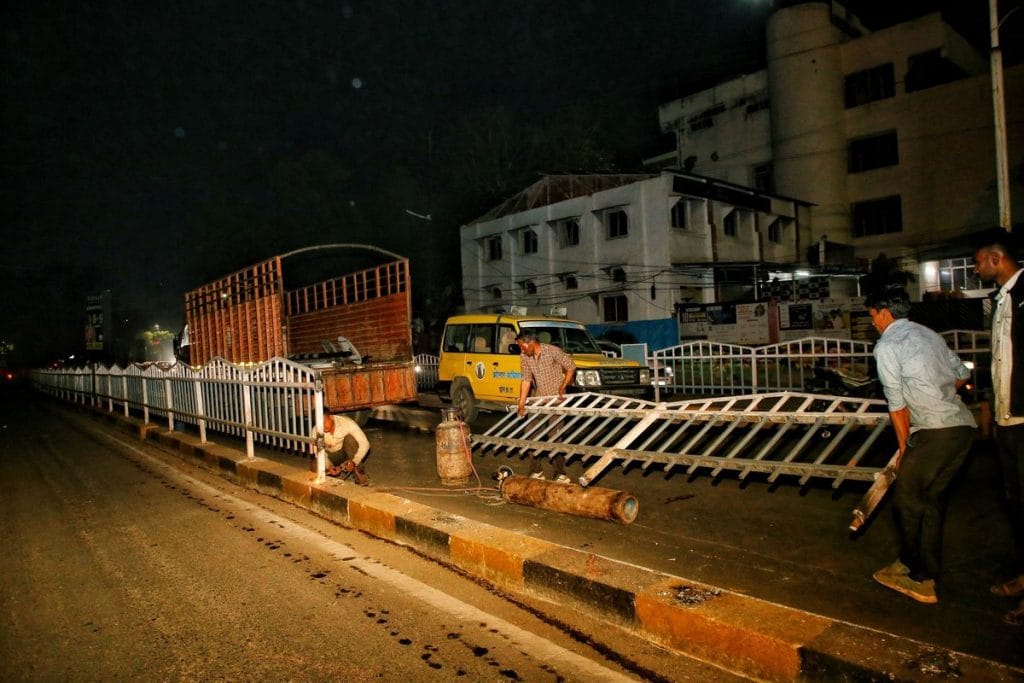
The BRT was meant to be a rational, sustainable way to decongest roads and improve public transport. Instead, it became shorthand for urban chaos, ridiculed in some quarters as socialism-on-the-roads. Meanwhile, the total number of buses running on Indian roads is still one-tenth the requirement. Urban India has just over 47,000 buses, and only around 24,000 of them are actually on the roads, according to data from the Ministry of Road Transport and Highways.
The BRT systems in India were designed to fail, according to Ashish Verma, professor of Transportation Systems Engineering at the Indian Institute of Sciences (IISc).
“Our municipal bodies mindlessly copied the hard infrastructure model of Bogota in Indian cities, without appreciating the operational plans,” Verma told ThePrint at his Bengaluru office. He said Bogota designed its BRT system to serve high passenger volumes, but India “implemented the system where right of way was available instead of analysing demand”.
Also Read: DTC’s lost decade—model fleet to mess. Electric overhaul is the new hope
How the BRT came to be
In the mid-1990s, Indian civic planners were grappling with a concept that was still fairly new: sustainability. A tired, unachieved promise now, it was the buzzword then. Amid post-liberalisation growth, scientists and policymakers were looking for systems that could make Indian cities more sustainable.
Public transport was central to the discussion. The Delhi Metro was just coming up, and planners were scouting for infra to complement it.
Around this time, a group of experts led by IIT Delhi’s Dinesh Mohan, a transport specialist known for his scepticism of the metro, began lobbying for a Bus Rapid Transit System. The BRT, as envisaged by the team, later found a prominent place in the 2006 National Urban Transport Policy (NUTP) as a sustainable, low-cost solution to India’s increasingly congested roads.
Even if Delhi had received an 18-kilometre corridor, it would have failed. BRTS will fail unless there is network-level connectivity, operational plans in hand, fast frequency of buses, and high passenger capacity of buses
-Ashish Verma, professor of Transportation Systems Engineering, IISc
Inspiration also came from cities across Latin America and Asia—including Brazil, Colombia, China—that were building separate corridors for their buses to speed up commutes. Even European countries like France jumped on the BRT bandwagon. Brazilian architect Jaime Lerner, widely credited as the pioneer of rapid bus systems, had introduced a system in Curitiba with pre-paid boarding and dedicated lanes in the 1970s. The system was later adopted by Bogota and Rio de Janeiro.
“In the late 90s and early 2000s, discussions on sustainability in cities were picking up steam, and that is when we started looking at global BRT systems,” recalled IIT civil engineering professor Geetam Tiwari, who was instrumental in overseeing the implementation of the BRTS in New Delhi. “Crash data showed that buses were interacting with cycles, leading to clashes. We were in touch with our global colleagues too, who were solving the congestion problem by taking buses out of mixed traffic.”
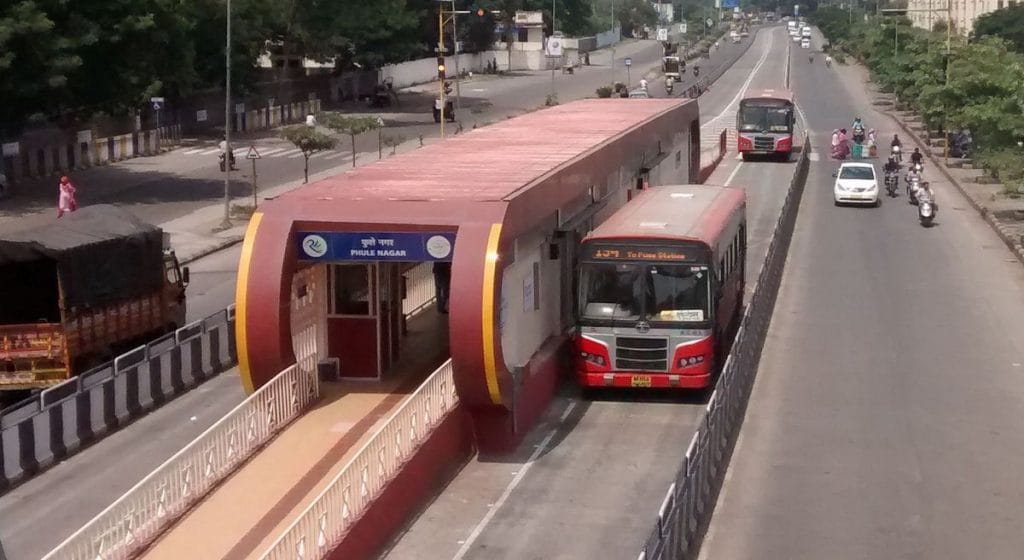
The 2006 NUTP, under then urban development minister Jaipal Reddy, framed BRTS as a pedestrian-friendly, sustainable option. The policy document began with a projection that India’s urban population would grow from 285 million in 2001 to 473 million by 2021, and 820 million by 2051.
“Hence, cities must not only meet the mobility needs of the current population but also provide for the needs of those yet to join the urban population,” it read.
The policy batted for sustainable, affordable public transport, and BRTS featured prominently. While it cited the examples of Bogota and Curitiba, it noted that solutions had to be tailored to specific urban contexts and that transport systems should be weaved in at the city-planning stage, not slapped on as an afterthought.
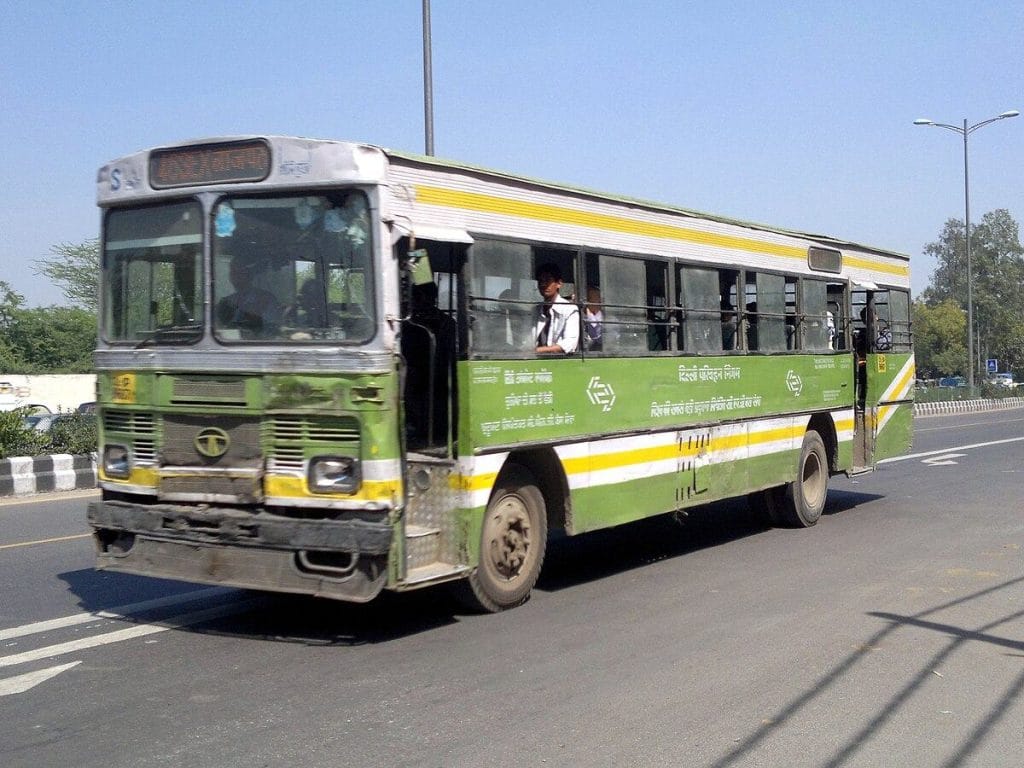
On the basis of NUTP 2006, the UPA government launched the Jawaharlal Nehru National Urban Renewal Mission (JNNURM), under which the Centre sanctioned over Rs 1 lakh crore to 21 cities for BRTS infrastructure in 2011. These included Jaipur, Indore, Delhi, Kolkata, and Vijayawada. Only nine cities ended up implementing the system, at a total cost of Rs 4,700 crore.
Most BRT projects were entrusted to municipal corporations though special purpose vehicles, like JVSTL in Jaipur and Janmarg in Ahmedabad. The pilot projects were rolled out in Pune and Delhi.
Right from the outset, Delhi’s 5.8-kilometre-long pilot stretch from Moolchand to Ambedkar Nagar started flailing.
“Even if Delhi had received an 18-kilometre corridor, it would have failed,” said Verma. “BRTS will fail unless there is network-level connectivity, operational plans in hand, fast frequency of buses, and high passenger capacity of buses.”
Designed to fail?
The Delhi BRTS got bad press from the day it was launched. Times of India called it ‘traumatic’, while Indian Express termed it ‘Lane Raj’. Stories of traffic jams and accidents became commonplace, and there was instant pressure on the Sheila Dikshit government to scrap it.
While Bogota is often cited as the model, Tiwari said the experts also derived learnings from cities like Taipei, and that the original vision wasn’t to create walled-off lanes but to also allow non-BRT buses and other light vehicles like two wheelers.
The intent behind the Bus Rapid Transit system was sound, according to Shailaja Chandra, former Chief Secretary of Delhi. She notes that it was based on successful examples in other cities, both within India and abroad.
“In 2002, 62 per cent of Delhi commuters were using buses to commute, followed only by two-wheelers or autos. The Metro was still in its infancy, having started its inaugural stretch only in December 2002. It was essential to find a public transport alternative which could transport large sections of people quickly, without being hemmed in by another half a dozen modes of transport which constantly vied for road space,” she said.
But design and implementation fell short. Verma argued that Indian BRT systems like Delhi’s suffer due to their low passenger-per-hour-per-direction capacity.
For the BRT to be more successful, they should have added more buses, and it should not have been limited to the most difficult corridor in the city… If you take 35 to 40 per cent of the road in an important corridor but not enough buses, you create more chaos rather than facilitating anybody
– Satyendra Garg. former JCP (Traffic) in Delhi
A 50-seater bus running every 10 minutes carries 300 people but a regular traffic lane carries 1,200, Verma pointed out: “So unless bus capacity and frequency are increased, how on earth would a BRTS system succeed?”
In Delhi, the corridor was widely adjudged to be a public inconvenience, especially among car owners, who filed a “flurry of petitions” demanding access to the dedicated lanes. Public attitudes didn’t help either.
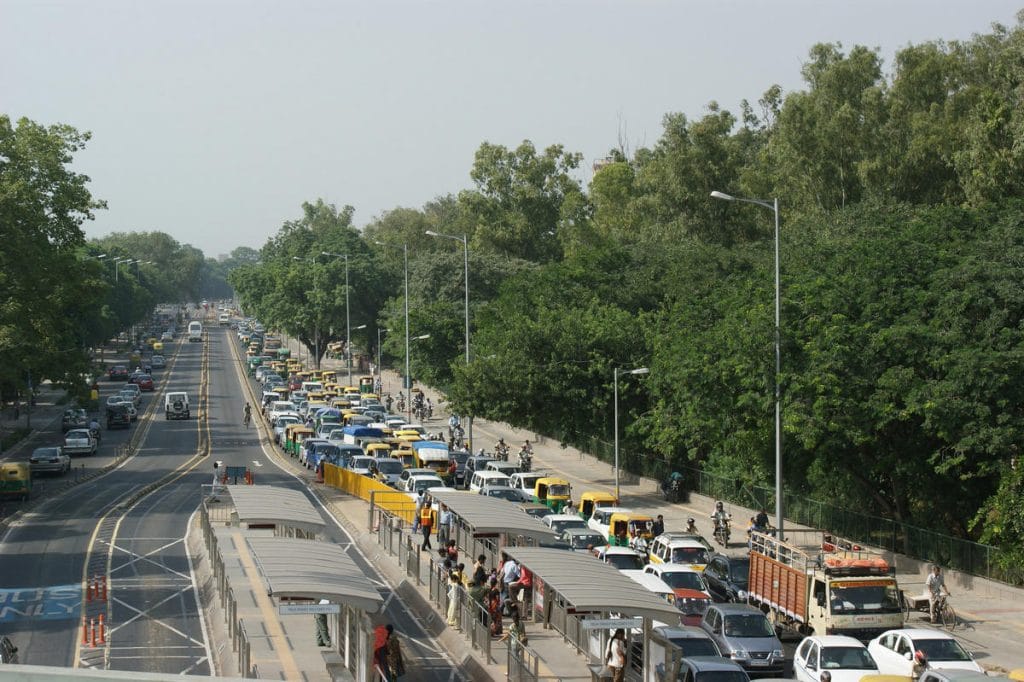
Congestion on the corridor became so bad that then Joint Commissioner of Police (Traffic), Satyendra Garg, often had to stand near Moolchand to manage traffic flow.
“For the BRT to be more successful, they should have added more buses, and it should not have been limited to the most difficult corridor in the city, which became dysfunctional for the six kilometres the BRT was superimposed,” Garg told ThePrint. “If you take 35 to 40 per cent of the road in an important corridor but not enough buses, you create more chaos rather than facilitating anybody.”
This situation was compounded by commuter attitudes and behaviour, according to urban infrastructure expert Tikender Pawar.
“The Indian commuter is extremely feudal,” he said. “They refuse to use public transport if they own a car. A system like BRT can’t survive in a place where there’s no civic sense.”
Chandra recalled that the late Chief Minister Sheila Dikshit, though usually very persuasive, was unable to get public support for the BRT project. Yet though Dikshit didn’t expand the pilot project, which was meant to be 18 kilometres long, she did not scrap it altogether. That job was finally done by the Aam Aadmi Party, which dismantled it to applause in January 2016.
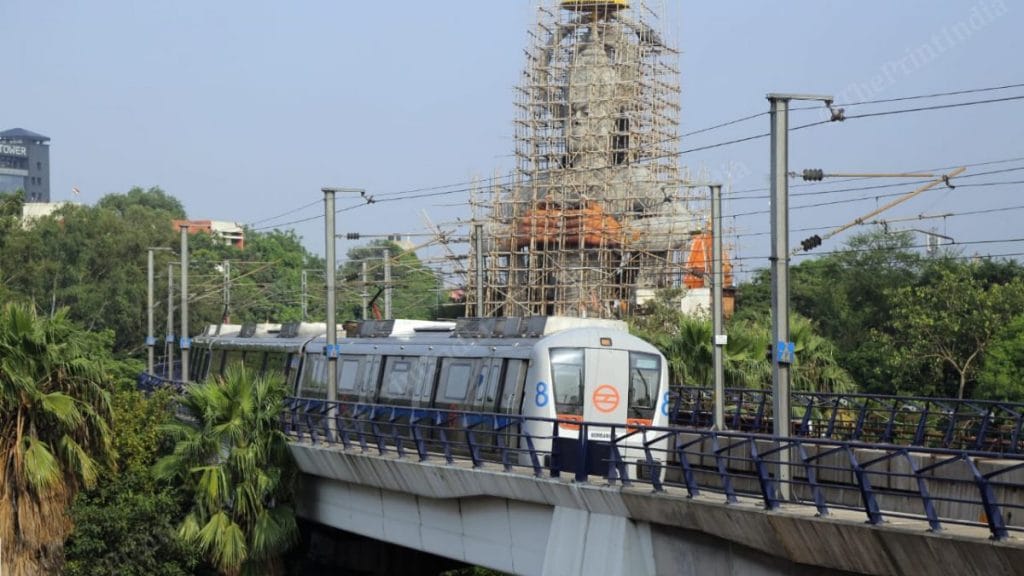
Delhi’s BRT failure, contrasted with the Metro’s raging success, set the tone for how other cities approached mass transit. After 2014, metros gained favour with the central and state governments. A 2022 Comptroller and Auditor General (CAG) report, ‘Bus Rapid Transit In India’, also noted that “less attention has been paid to BRT’s since the emergence of metro services”.
But the pattern may be repeating. Even as Indian cities stand in line to get metro approvals, most of these trains run below capacity. For tier-2 towns, Verma warns, they could become white elephants — high-cost infrastructure with limited utility, much like BRT.
Delhi is not the only story of a failed BRT. Lack of political will and public pushback led to projects being abandoned midway in other Indian cities as well.
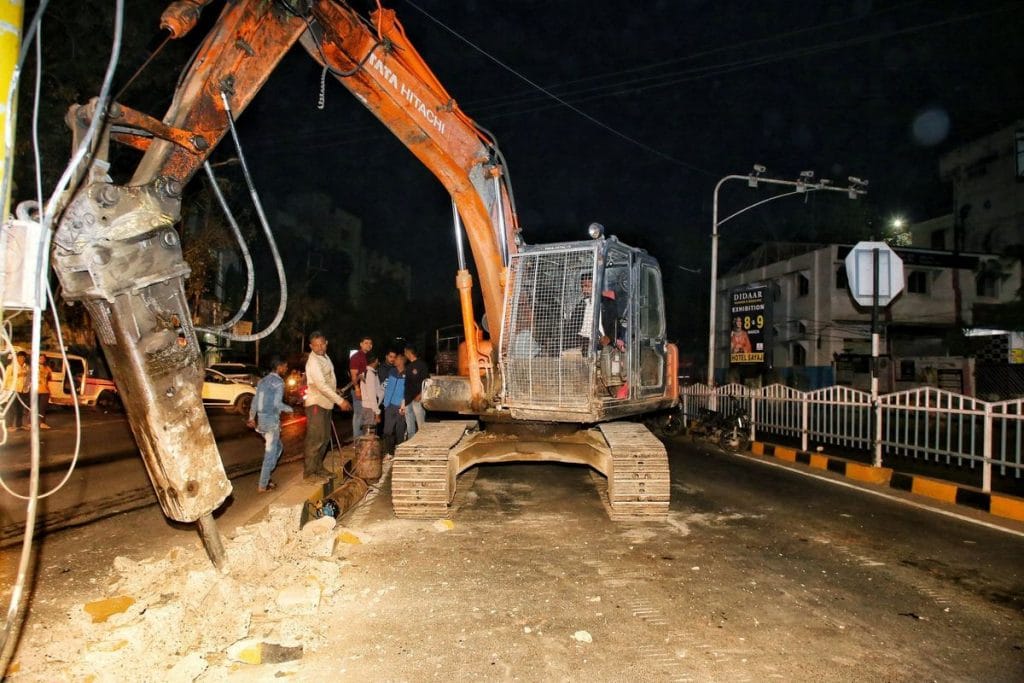
The BRT project in Vizag has still not been completed, and though state buses use the corridors, the project has not been formally launched yet. Vijayawada’s 15-kilometre project was quietly reduced to four kilometres, and has even been described as just a “long clothesline”.
While officials from Jaipur went to Delhi to understand “what not to do” when launching the BRTS project, the system went down the drain here too. It failed to win people’s support, stop cars from entering the bus lanes, or make passenger’s lives any easier.
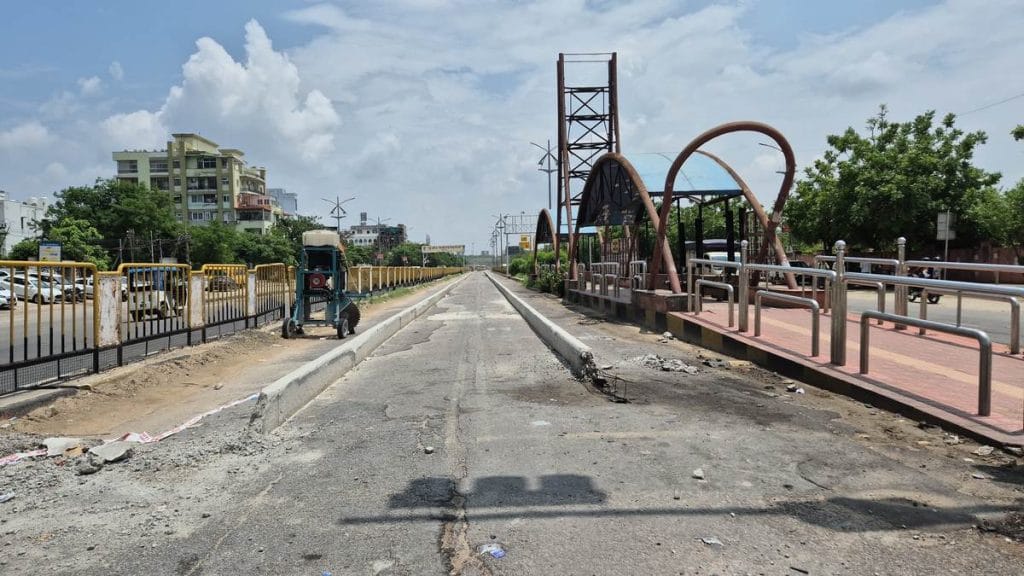
‘Jaipur never saw BRTS’
Black and yellow BRTS barricades are being dismantled one at a time in Jaipur. They’ve been a thorn in its side since 2010.
“Better sense has prevailed,” said a resident waiting in his car at a traffic signal near the corridor. “The congestion here is pathetic. Once these two lanes open up, we’ll breathe a sigh of relief.”
The Pink City, an expert at preserving its heritage, has stumbled when it comes to managing modernity. It is the eleventh largest city in India, but has no functional public transport system.
Jaipur has just 10 buses per lakh population, with most residents relying on two-wheelers or autos to get around.
The few buses that do ply—including mini buses and inter-city carriers—still occasionally stop at the condemned BRT terminals, even as cars and bikes zoom by.
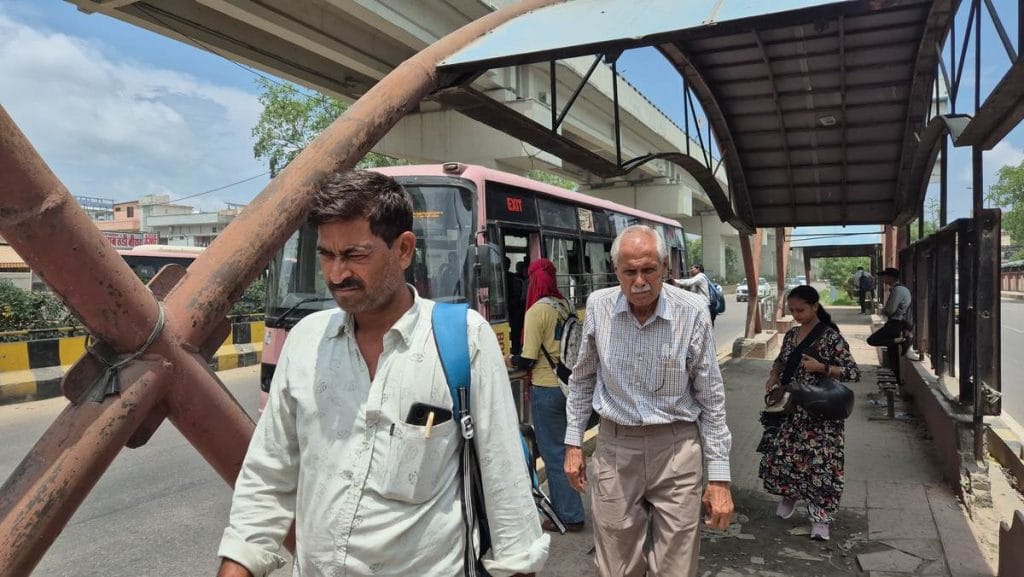
“It is not like other bus stops are any better, but these bus stops at least provide a safe space for us to stand and wait,” said Maneka, a domestic worker who was waiting for her regular bus.
Jaipur was among the nine cities chosen for BRTS under JNNURM, with the state and Centre channelling over Rs 470 crore into the project.
Sources who worked on the project in the inception stage said ministers and officials travelled from Ahmedabad to Bogota. No useful notes seemed to have been brought back. Part of the budget was for awareness generation, but public buy-in was a problem from the outset.
BRTS is a well of death. It causes a lot of accidents. It is our responsibility to reduce these deaths
-Pratap Singh Khachariyawas, forer Rajasthan transport minister
The idea at first was to ease congestion on arterial routes like Tonk Road. The initial proposal, said sources, envisioned two main corridors: a north-south one connecting Tonk Road and Sikar Road, and an east-west one from Ajmer Road to Delhi Road. Elevated stretches at Pani Pech and Durgapura were also planned.
But almost from the start, the Jaipur Development Authority (JDA) ran into resistance.
“When we started working at Durgapura, we faced a lot of backlash. People didn’t want us to usurp any part of the road,” said a JDA official.
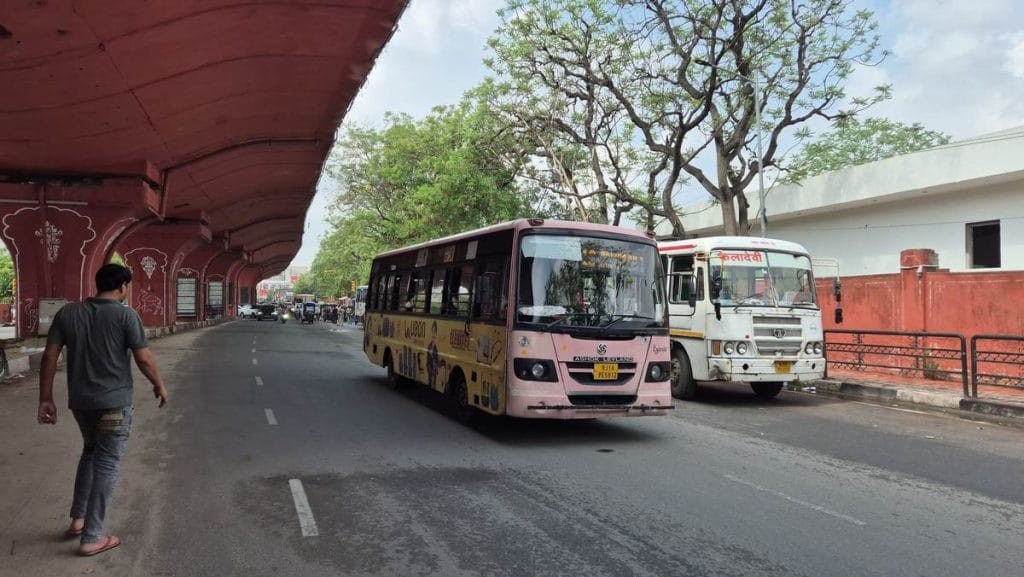
After this pushback, officials retreated and chose the upcoming areas of Sikar Road and New Sanganer Road, which were wider than 45 metres.
Inaugurated in 2010, the corridor was promised 300 buses, bought under the JNNURM scheme, but these vehicles were diverted to more ‘important’ routes such as Tonk Road.
At the Sikar Road corridor, bus frequency and regularity were poor. Only a handful of buses based at the Sikar Road depot used it—usually just to enter the depot. The corridor at New Sanganer Road was not operational at all.
“Jaipur never got to even taste BRTS,” the source in the JDA said. “The buses should have been as punctual as the metro. It is metro on wheels—it’s not simply a corridor. But it never really took off.”
Anatomy of a failure
In the end, Jaipur was left with two corridors, barely any buses, and a pile of new problems. The BRT lanes became a playground for stunt bikers, junctions grew chaotic, and passengers were forced to fend for themselves as mini buses refused to stop at designated terminals, as there just weren’t enough commuters there.
The 2022 CAG report noted that Jaipur BRT recorded the lowest number of passengers among all cities with the system. The city’s biggest problem is that it only has 100 state-run low floor buses on the road. Instead, around 1,000 privately owned mini buses take the place of public transport, usually ferrying blue-collar workers and students.
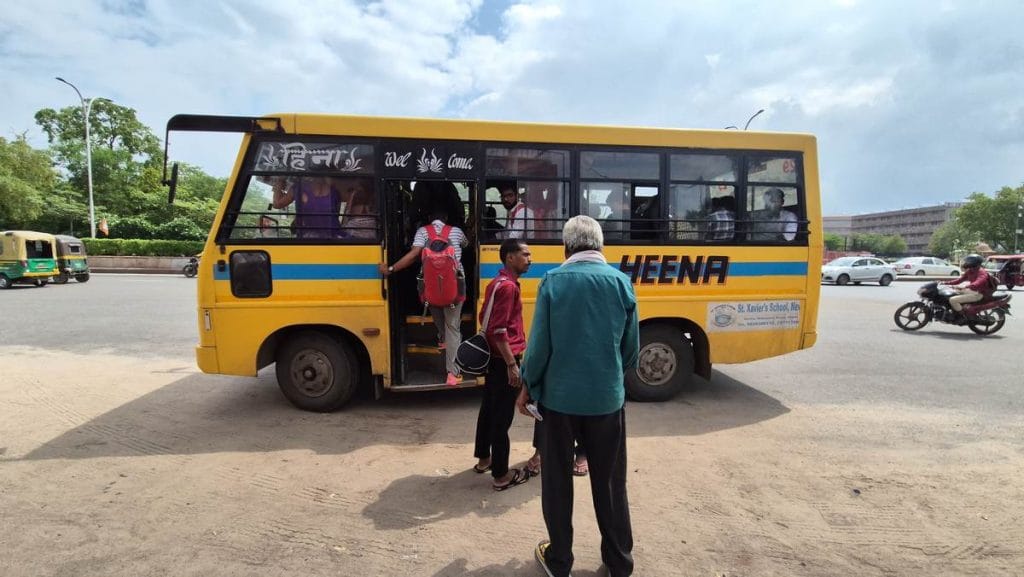
Quite early on, it became clear that the BRTS was never going to be of any use. The design, for one, was chaotic. In just 8 kilometres, the Sikar Road corridor had 11 junctions. Each one had a football field-like crossing that passengers struggled to navigate. Mini buses also on-boarded passengers at these junctions, rather than at the designated bus stops.
But former heads of the JDA and the special purpose vehicle JCTSL had no answers for what went wrong. Narayan Singh, current managing director of the JCTSL, admitted he had “no data” on how many buses used the corridor or how many people benefited.
The bus stretches chosen for [Jaipur] BRT were very short. It lacked feeder transport. There needs to be an integration of mass transit facilities, like metro, buses, e-rickshaws. Without integration, any system will be a failure
-Anirudh Mathur, traffic engineering and road safety auditor
Last year, the Central Road Research Institute (CRRI) was brought in to study the feasibility of the BRT project. In a 2025 report, CRRI noted traffic movement was faster near BRT lanes but still recommended tearing down the corridors.
It was also a question of safety, according to Neha Khullar, director (projects) at Muskaan Foundation for Road Safety, which was part of the Traffic Control Board when BRTS was introduced
“We had told JDA from the very beginning that this design of having a bus corridor in the middle of the road may prove fatal for the pedestrian,” Khullar said of the Sikar Road stretch.
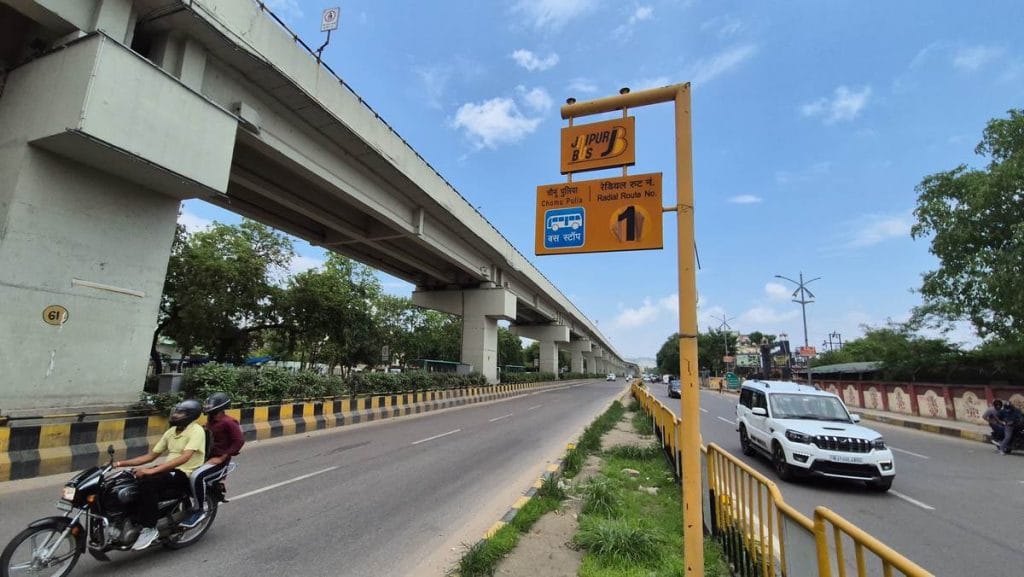
The second corridor, on New Sanganer Road, was also underutilised. There were few commuters in the area, so mini buses preferred to ply the more commercially active Madhyam Marg nearby.
“Youth started speeding and racing in the BRT corridor on New Sanganer Road, performing stunts, so it became a fatal stretch,” Khullar added.
For Khullar, BRTS was a need of the hour for Jaipur, but it failed because of its design flaws, lack of need assessment, no last mile connectivity, and shortage of buses.
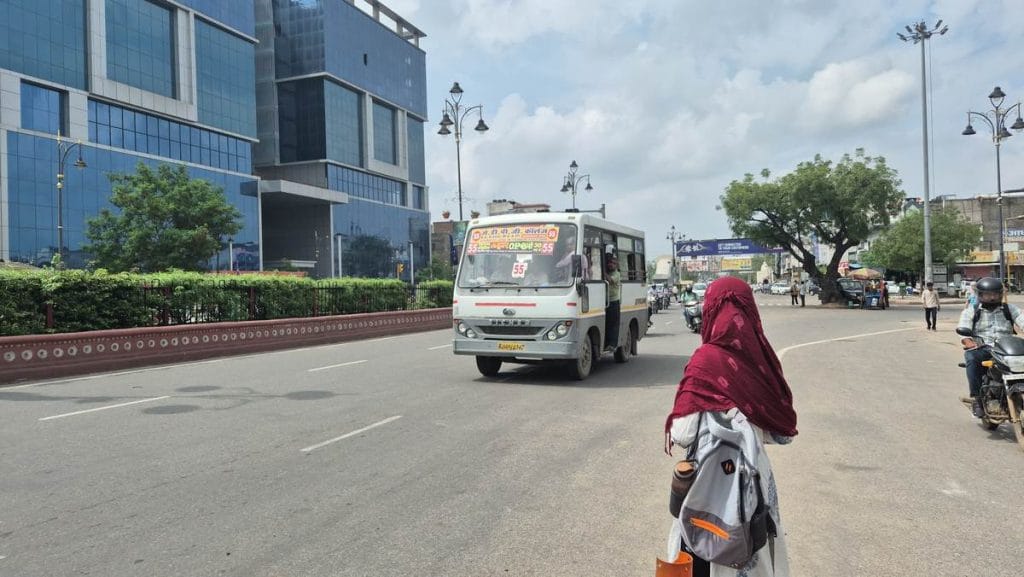
About Rs 270 crore from the BRT budget was also spent on elevated roads—areas where the corridor was never functional.
“The bus stretches chosen for BRT were very short. It lacked feeder transport,” said Anirudh Mathur, a traffic engineering and road safety auditor who had earlier reviewed the Jaipur BRT. “Any type of system needs time. There needs to be an integration of mass transit facilities, like metro, buses, e-rickshaws. Without integration, any system will be a failure.”
But even in cities where the BRTS is technically functional, the system remains deeply unpopular.
Polarising issue in Hubballi-Dharwad
Ishwar Shivalli is still haunted by the memory of his friend breathing his last in his lap. “He could have been saved, he could have been saved,” he said, slouching. For that loss two years ago, Shivalli blames the 22-kilometre corridor that connects the twin cities of Hubballi (also called Hubli) and Dharwad in North Karnataka.
That day, Shivalli had been rushing his friend, who’d been critically injured in a road accident, to a hospital. But even with a patient in the car, traffic cops at junctions refused to let him use the BRT lane.
The very next day, Shivalli, a Congress worker, convened a meeting with the city’s grassroots leaders and founded Dharwad Dhwani, an organisation that’s demanding that the BRTS be opened to all vehicles.
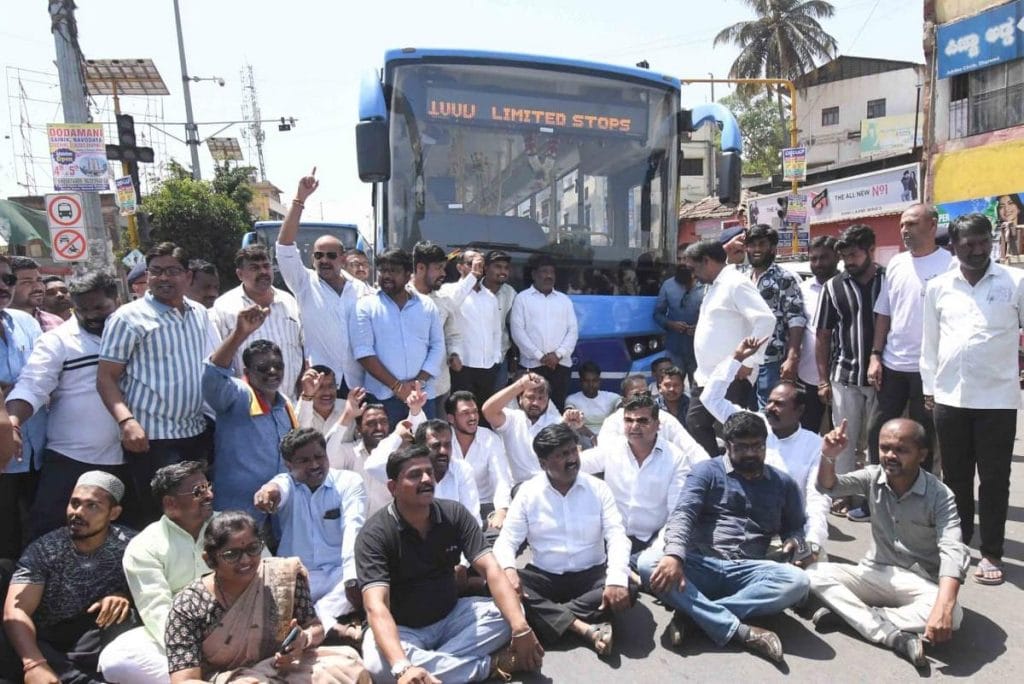
“The corridor causes Bangalore-like traffic. We demand it becomes a mixed-use traffic corridor,” said Shivalli, who has consolidated support from different party leaders in Hubballi-Dharwad.
On 5 March, about 500 Dharwad Dhwani members saton the road, blocking BRT movement. “BRTS byan byan” (Down down BRTS), they shouted. “BRTS sarvajanik karge, BRTS road valle, road dalli, mukvagi” (Make the BRTS road public, free it for us).
Over the last two years, Dharwad Dhvani has organised multiple protests, with members even being detained by the police. They’ve blocked BRT lanes, marched to the commissioner’s office and collectorate, and submitted memorandums. Auto and trader unions have joined in. They want one thing: remove the BRT.
Every day 500-700 new vehicles are registered in Hubballi-Dharwad, which comes on the main trunk road. The BRT used to have 150 buses, which has now reduced to 70-80. The BRT corridor is empty, while the public road is jammed. Is it justified?
-Ishwar Shivalli, Congress leader and founder of Dharwad Dhwani
Unlike Jaipur’s non-functional system, Hubballi-Dharwad’s BRT actually runs frequent buses. Eighty-five dedicated blue AC buses connect the twin cities through the four-lane corridor. These buses have exclusive access—even state buses are not allowed to ply here.
This system functions like a metro. The buses are conductor-less, with QR-code tickets to get in and out of stations. There are separate doors for entry and exit. The buses run every three minutes, according to the city’s BRTS body. Roughly 2.2 lakh people commute daily between Hubballi and Dharwad, and of these, nearly 85,000 use the BRTS.
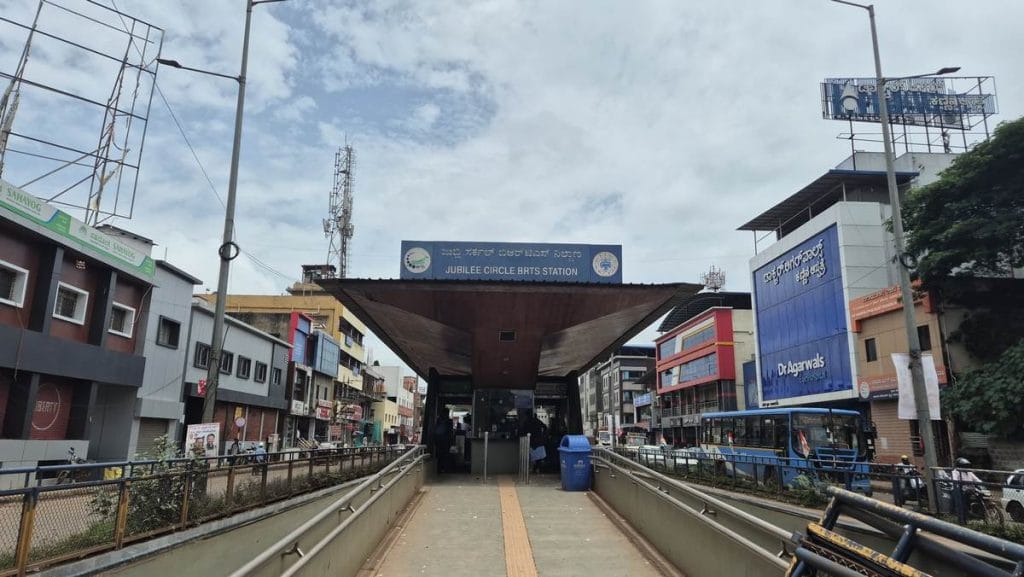
The corridor is a polarising issue. Students, senior citizens, and daily commuters praise the service. But roadside vendors, businesspeople, and private vehicle users harbour disdain for it.
“We’re not asking them to stop the blue buses,” said Shivalli. “But they should run in mixed traffic in the city, from Jubilee Circle to Navloor Bridge.”
Shivalli and his group argue that while the corridor may serve some, it leaves others stuck in jams. The fact that state-run buses can’t use the corridor also adds to congestion.
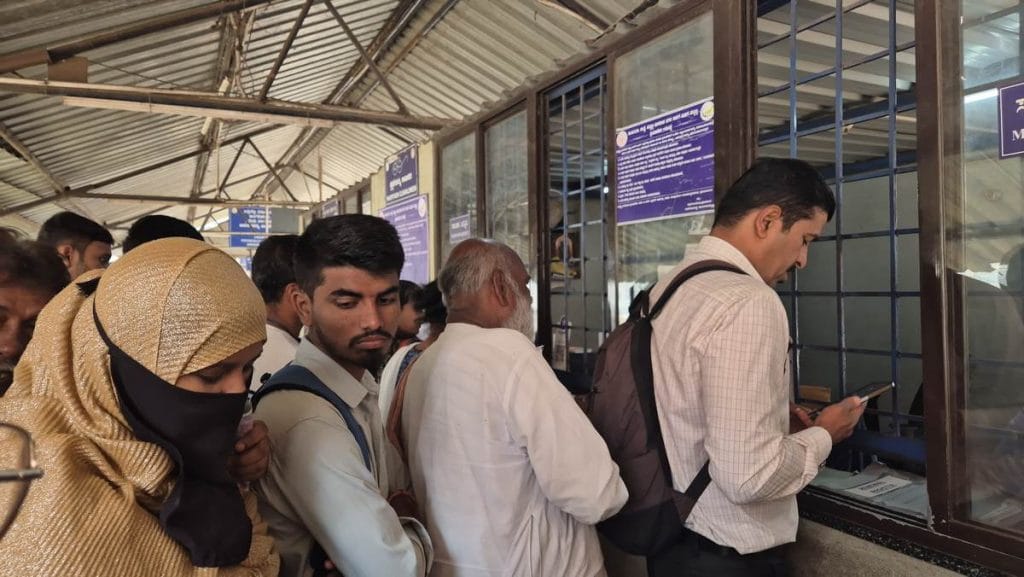
“Every day 500-700 new vehicles are registered in Hubballi-Dharwad, which comes on the main trunk road. The BRT used to have 150 buses, which has now reduced to 70-80. The BRT corridor is empty, while the public road is jammed. Is it justified?” he asked.
Dharwad Dhwani also argues that the BRTS has led to more accidents, and even hurt local businesses in places where barricading for the system has come up.
One example is the Sangam Circle market on Lakshmi Talkies Road. Once among Dharwad’s busiest commercial hubs, it’s now largely a parking spot for BRT commuters. Shops are closing down and customers have thinned out.
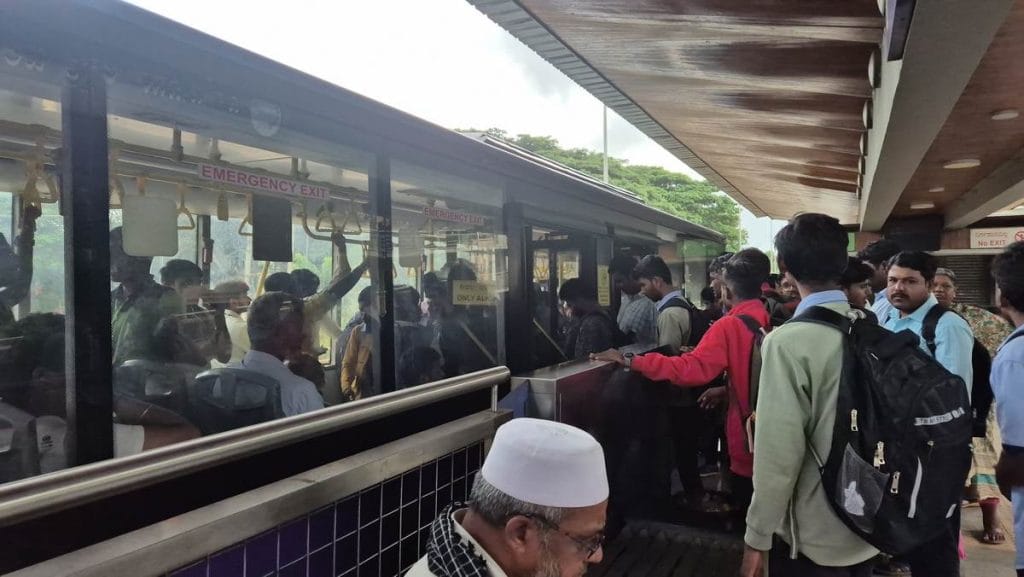
The road was cut in half by the BRT corridor and no U-turns or underpasses were made.
“This market was a thriving one, but ever since they shut the road, people have stopped coming. The road used to connect the city, now it is nothing more than a parking lot,” Narendra Patel, a shopkeeper, said.
With no last-mile connectivity or parking, BRT users rely on autos or leave their own vehicles parked along nearby streets, adding to the fury of other residents.
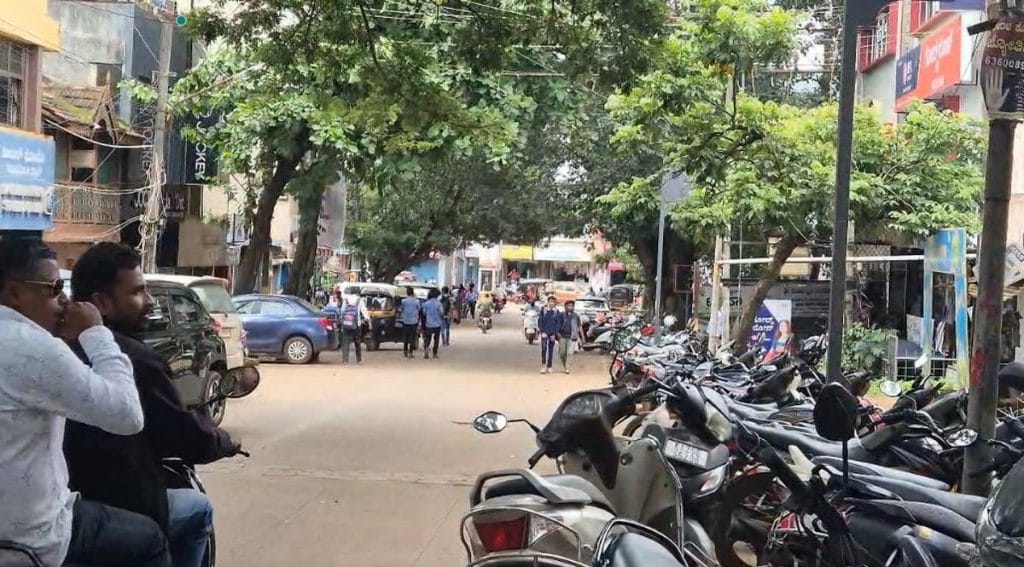
BRTS officials, however, say the system is working well, despite running at a loss of Rs 33 per kilometre. Instead, they blame the people.
“We have done several awareness campaigns for the general public, but they fail to understand that the congestion is caused by their reliance on private transport when a good alternative is available,” an official said. “They see an empty BRTS road while stuck in traffic and wish for a wider road. But widening roads is not going to solve congestion.”
The demands of Dharwad Dhwani and other organisations are being considered, BRTS officials added.
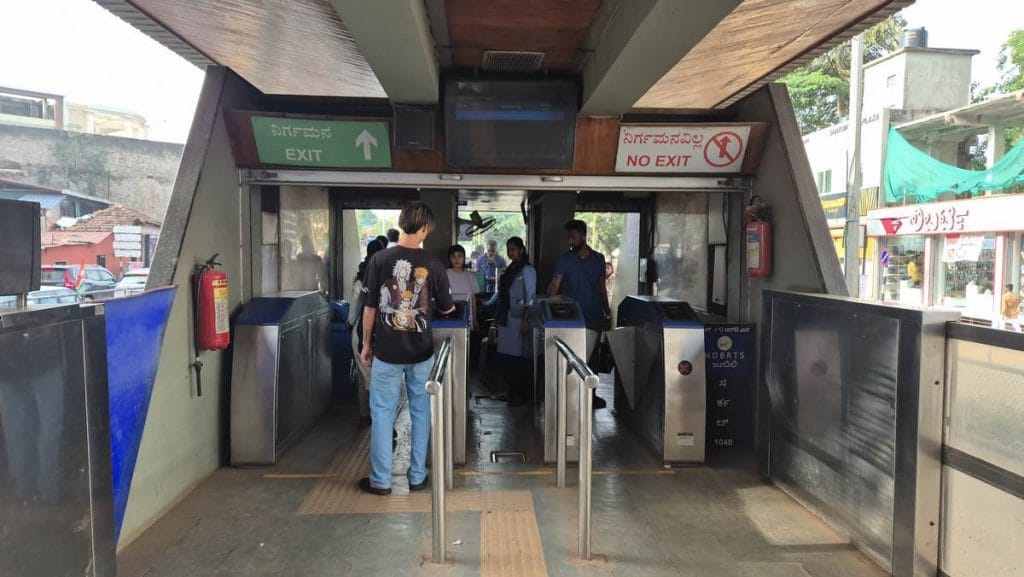
Sanctioned in 2012 when BJP’s Jagadish Shettar, a native of Hubballi, was Karnataka Chief Minister, the Rs 970 crore project was partly funded by the World Bank. ThePrint contacted Shettar by phone, but he declined to comment, citing travel.
BJP leader and current Hubli-Dharwad (West) MLA Arvind Bellad is among the critics of the way the project has panned out.
“The way it is designed has created havoc for people. For 85 buses, there are four dedicated lanes, whereas for mixed traffic, there are two lanes on either side. There is no space provided for parking, or footpaths for pedestrians. Mixed traffic commuters are getting harassed,” Bellad said.
BRTS ‘success stories’
Most Indian BRT systems are on their last legs, or if not that, then sorely resented. But a handful of cities still treat them like crown jewels.
While Pune is getting rid of its Rainbow BRT line, neighbouring Pimpri-Chinchwad is holding on.
Municipal commissioner Shekhar Singh told ThePrint that the BRT complements the city’s metro and eases traffic on the Pune-Mumbai highway, ferrying 3.6 lakh commuters daily. It began in 2010-11 with three corridors. Now it has four, with a fifth on the way. The city has also included BRTS in its 2050 comprehensive mobility plan.
A wide right of way—the corridor uses just 15 per cent of the road space along the old Mumbai-Pune highway—and frequent service have helped Pimpri-Chinchwad’s BRT succeed, according to Singh.
“All our roads where there are BRTS corridors are 45 to 60 metres wide, and they have been designed carefully, keeping passenger direction in mind. The corridor is now 54 kilometres long,” he said.
In Gujarat, Surat wants to expand its BRTS across 95 per cent of the city by 2046, and has started acquiring more buses for it. It already claims to have India’s longest BRT corridor at 102 kilometres, carrying 85,000 people every day.
But the star of India’s BRT story is Ahmedabad, a city where urban experts and officials are regularly dispatched to study its well-oiled system.
The BRTS primarily serves a diverse population in Ahmedabad with a significant portion belonging to lower- and middle-income groups
-Janmarg official
Called Janmarg, Ahmedabad’s BRT network spans 89 kilometres and transports 1.6 lakh commuters daily. It runs 200 electric and 150 CNG buses at 10-minute intervals.
Yet, though often hailed as a success, even Janmarg is beginning to creak. Earlier this year, Dainik Bhaskar reported that BRTS buses run on 89 kilometers of exclusive corridor, but “merge with common traffic on the remaining 78 kilometers”. Services have reportedly become less frequent and reliable. “Era of seamless travel stalls,” read the headline.
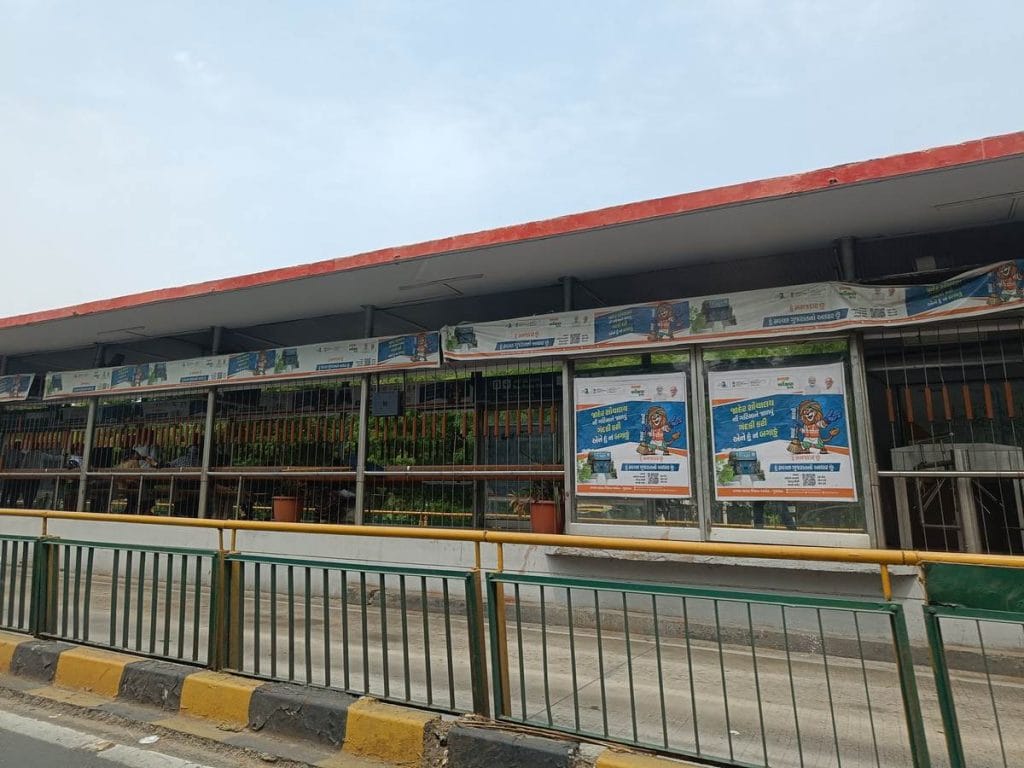
The city plans to acquire 260 more e-buses by year-end at a cost of Rs 1,800 crore. But last-mile connectivity remains a problem. A CEPT University study found that 67 per cent of public transport users in Ahmedabad still need to switch modes to reach their final destination.
“The BRTS primarily serves a diverse population in Ahmedabad with a significant portion belonging to lower- and middle-income groups,” a Janmarg official said over e-mail. “The bus network covers all four sides of the city.”
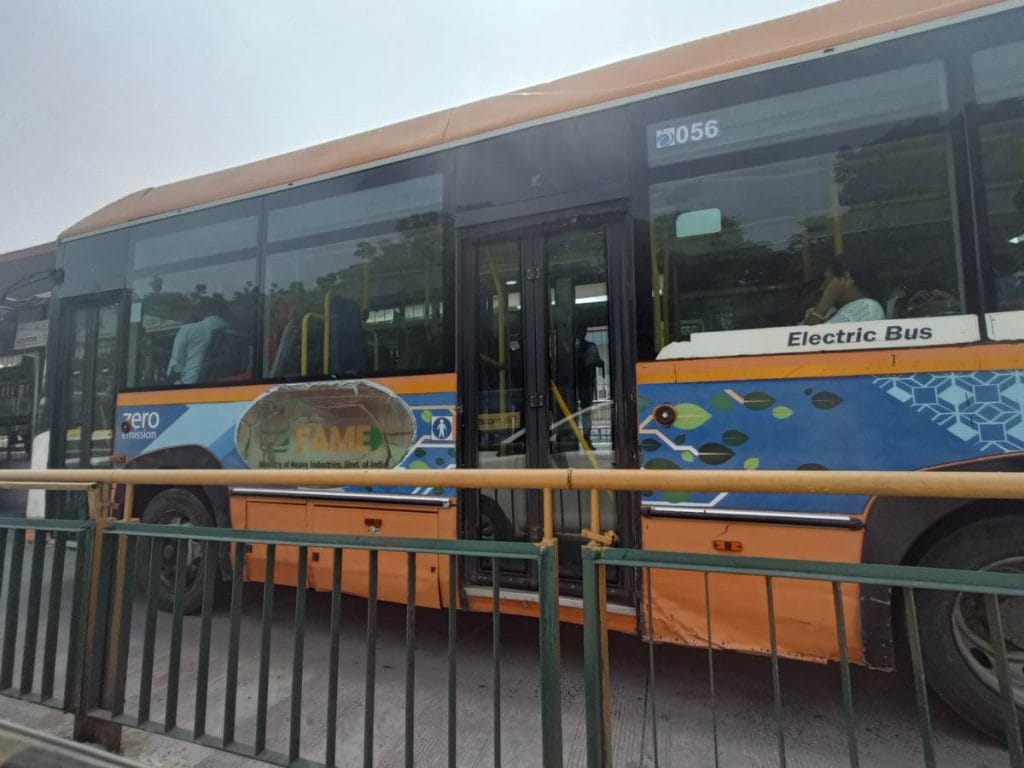
However, Janmarg chairman Banchhanidhi Pani, deputy municipal commissioner Amrutesh Aurangabadkar, and CEPT professor Shivanand Swamy did not respond to repeated e-mail and phone requests for comment.
Back in Jaipur, JDA officials look at the Janmarg with a bit of envy.
“Gujarat had political will, the chief minister was Narendra Modi back then and he saw to it that the project was completed,” the JDA official said.
Meanwhile in Pune, the oldest BRT project in the country is finally giving up the ghost.
Also Read: Jaipur, Agra, Lucknow got big status with metros. It’s all pride, no profit or passengers
Bad math
When the Pune Municipal Corporation started dismantling its Rainbow BRTS in April, activist Qaneez Sukhrani was vindicated.
“From the very beginning I have maintained that the system is flawed, impractical, and leads to snarls on the roads,” she told ThePrint over the phone.
For almost three years, Sukhrani says she walked the streets with PMC officials, trying to incorporate citizen concerns into the system’s design. Nothing came of it. Finally, as public outcry over congestion on areas like Nagar Road grew, Maharashtra Deputy Chief Minister Ajit Pawar ordered the corridor removed.
Yet, despite failures across cities, some experts still hold back from writing off the BRT model.
“You cannot build endless space for cars. The more space you build, the more cars will fill it,” professor Tiwari said.
For IISc’s Verma, BRTS networks should not be scrapped without a serious attempt at improvement.
“Bhopal and Indore will come to regret dismantling their BRTS,” he said.
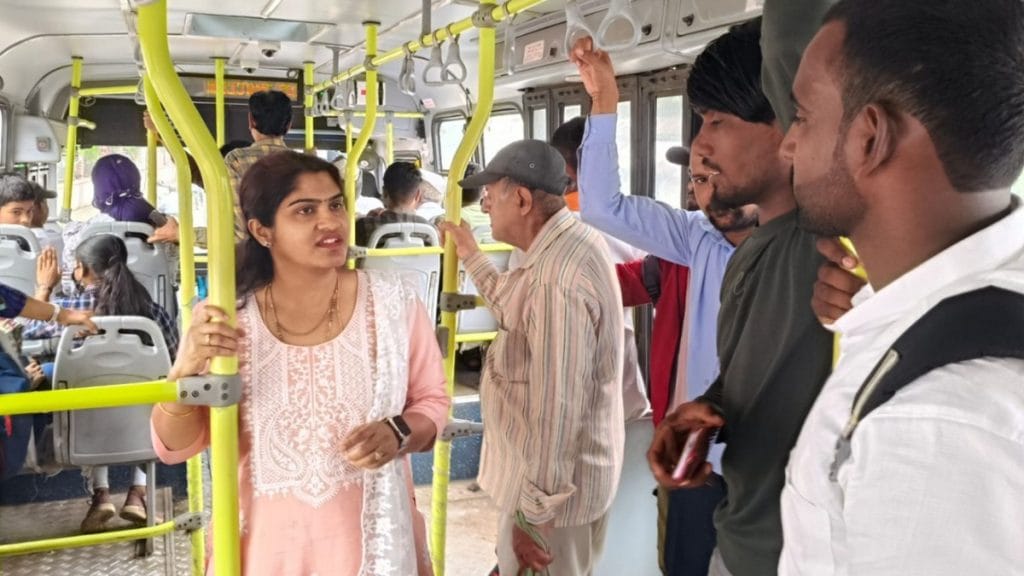
But numbers indicate that India’s BRT networks pale in comparison to global standards. Ahmedabad, one of India’s few BRT ‘success stories’, runs just 20 buses an hour, with a peak load of 1,780 passengers per hour per direction, according to the 2022 CAG report. In contrast, frequency leaders like Rio de Janeiro and Guangzhou run 600 and 350 buses an hour, respectively. For peak load, Sao Paulo handles 98,000 passengers per hour per direction, and Rio 65,000.
Peru had the best BRT performance, said the CAG report, as it carried more than 27,000 passengers per day per kilometre—12.5 times more than India’s 2,182. China carried 6,155.
Crashes have also turned public sentiment in India against BRT. In Jaipur, former transport minister Pratap Singh Khachariyawas blamed BRTS for repeated accidents and called for action against “experts” who had advocated for it.
“BRTS is a well of death. It causes a lot of accidents. It is our responsibility to reduce these deaths, so we stopped operations long ago,” he told ThePrint.
Mathematically or emotionally, India’s BRTS became a classic case of 2+2 equals 3.
In Pune, Sukhrani recounts how concerns over the narrow Nagar Road were ignored when the project started. It was not part of the initial plan and there “was a lot of opposition from all sides” because citizens didn’t want U-turns and dividers to be blocked.
“The beginning of it was very negative,” she said. For most cities, so was the end.
This is the first article in Urban Pressure, a series on how bad planning is choking Indian cities.
(Edited by Asavari Singh)



